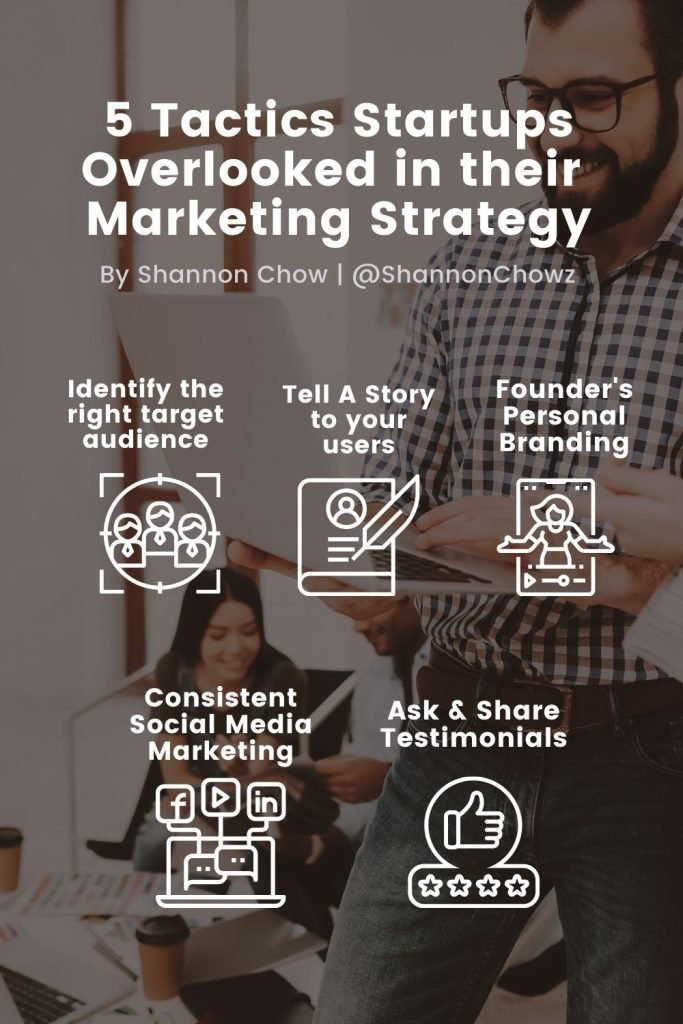
As a marketer, I’m always curious about checking out new businesses & existing startups how they market their brand & products. Coming from a creative & digital agency background to joining Venture Capital/Startups, I’m aware I had to make adjustments to my strategy in marketing. We don’t have a huge marketing budget & a big team to make things work, but I’ve seen some startups & micro SMEs who have established their brand from the ground up with little resources.
While mentoring startups, I realised many have not included these 5 tactics in their marketing strategy. I hope these tips will help you grow your business for startups & SMEs.
1. Identify the right target audience
Many people thought they knew who their target audience was, we hear vague target audience such as college students. However, getting the right target audience is the first step in your marketing strategy before identifying what’s the key message (story) & channels to use. To identify who’s your target audience, you should have a customer persona & a buyer user journey. It should be as detailed as possible, giving it a name & an avatar.
- Some questions to consider:
- What’s their demographic?
- gender, age group, location (currently located)…etc
- What’s their Psychographics?
- What’s their major? Are they from a private/public university?
- Are they local, do they stay with their family or in a hostel/rented accommodation?
- What do they do during their leisure time? Do they enjoy playing sports like basketball or badminton? Or do they prefer esports like Dota2, Valorant, pubg…etc?
- What’s their demographic?
By identifying your target audience you can then identify what are some of the problems they face by determining their buyer user journey and how you can bridge the gap by offering products/services that are solving the customer’s problems.
2. Tell a story
When you’ve identified your target audience, you’ll want to tell them a story about their problem & how you can solve it. During my agency days, we do tons of research on a particular target audience, to find out what ticks & putting ourselves in their shoes. Then we will have a key message. To develop the story & then come up with a headline that essentially represents the key message we want to deliver. To pitch to users, by convincing them they need this product/services through the various channels & types of creative assets.
Many startups focus on telling their story in a pitch deck to investors to raise funds, but do you tell your story to your customers to buy/use your products/services? Is your story clear & visible on your company’s social media account, website & conversation with your network of friends?
Establish your company’s mission & vision, you’ll know your product/services best, figure out your key message then translate it into all your communication which each piece of communication will convey the same story in various types of content; social post, a short video, a blog post, a press release etc.
The story has to be the same & synchronize across all your comms. If your brand is passionate about sustainability, it needs to be in your comms, starting from your brand colours, packaging (recyclable packaging), CSR projects (should be something about sustainability), if you’re selling an item you can opt to collect the old one and give users a rebate etc. Everything you do conveys that you are a sustainable company & you care for the environment.
3. Founder’s personal branding
Many founders are so busy building their business, they neglected their personal branding. You should be one of the industry thought leaders. If you’re a B2B SaaS platform, your audience is in LinkedIn then build your personal brand by providing content that adds value. If you’re B2C focused then perhaps building your brand on FB & Insta to your friends. Start with one platform & gradually build it across multiple channels. Some may think TikTok suits them better, it all depends where is your target audience hangs out.
Participate in industry associations or NGOs. There are also many business networking clubs, however, some may require more time & commitment than others. Building your brand name doesn’t mean hard selling. It’s about sharing your passion, your startup & something you do during leisure time it could be family time or a hobby. It’s about being relatable, some founders even share their key milestones, mistakes & their learning curve.
Building a personal brand means, letting others know what you do through building a connection. They may not be your customer but they can refer someone who could be your customer. After all, business is about relationships
4. Social Media Marketing
Consistent posting & always strive to create a viral post. You’ll never know what would go viral, but post consistently & checking your analytics which topic/type of posts performs the best, you’ll create something your users wants to see. With posting it’s not enough, optimize your profile bio & your channels should have a decent amount of followers.
Think of your business as a newly open cafe if it’s always empty chances are people think the food isn’t good. Whereas, a cafe with a queue, people think it’s so good that others are willing to wait to get a table. Similar concept, if all your posts are pretty & you’ve done consistent posting, invest in running ads specifically page likes to get some following & cross-promote across your channels like website & email to let others know you have a social media presence, eventually, you’ll get a decent following which ads credibility to your business.
You can also personally invite your friends to follow you on FB & Instagram, when you’re just getting started you can re-share some posts on your profile. Just don’t overdo it, nobody likes hard selling.
5. Allow users to share your story (Testimonials)
I say allow because not many businesses have enabled “reviews” tab on their Facebook or set up Google My Business to allow control of their company location to receive reviews. Have you set up an Insta Story Highlight to re-share your customer’s testimony? So others can view those testimonials whenever on your Instagram profile because IG Story is only limited to 24 hours but you can highlight it so the story is available on your profile forever.
How about your website? Have you included testimonials on your homepage website by featuring top testimony you’ve received? This adds credibility to your business.
Apart from setting up these basics, you got to ask for reviews, people don’t just drop testimony cause it’s out of their way so you need to make it as easy as possible for them. After they’ve purchased, ask them to drop you a review depending if it’s on your website or social. You will need to craft the user journey & determine which link to provide so your customer can easily drop their review.

I hope these 5 tips have been beneficial to include as part of your marketing strategy. Comment below to let me know which tip was essential for you and which tip you’ve completely missed out on your marketing strategy?
Leave a Reply